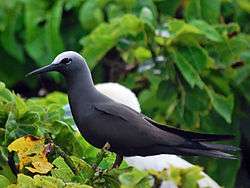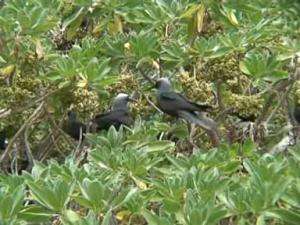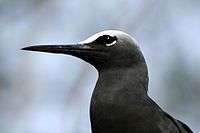Black noddy
| Black noddy | |
|---|---|
 | |
| A black noddy at the Tubbataha Reef National Park in the Philippines. | |
| Scientific classification | |
| Kingdom: | Animalia |
| Phylum: | Chordata |
| Class: | Aves |
| Order: | Charadriiformes |
| Family: | Sternidae |
| Genus: | Anous |
| Species: | A. minutus |
| Binomial name | |
| Anous minutus Boie, 1844 | |
 | |
| Global range Year-Round Range Summer Range Winter Range | |
The black noddy or white-capped noddy (Anous minutus) is a seabird from the tern family. It is a medium-sized bird with black plumage and a white cap. It resembles the closely related brown or common noddy (A. stolidus), but is smaller with darker plumage, a whiter cap, a longer, straighter beak and shorter tail. It was at one time, and sometimes still is, thought to be identical with this species.
Description
The black noddy is a medium-sized tern with a length of about 37 centimetres (15 in), a wingspan of about 70 centimetres (28 in) and a weight of 98 to 144 grams (3.5 to 5.1 oz). It has black plumage and a whitish cap, a small white crescent under each eye and a white spot above. It has long tapering wings and a truncated tail. The sharply-pointed bill is black as are the feet, which are fully webbed.[2]
Behaviour
These birds may have become known as "noddies" because of the behaviour of both sexes as they constantly dip their heads during their breeding display. They are very tolerant of humans even to the extent that they can be picked up off the nest. They feed on fish and squid which they gather by flying low over the surface of the sea and picking them up.[2] They may associate with other seabirds in areas where predatory fish are driving small fish to the surface.[1]
The nests of these birds consist of a level platform, often created in the branches of trees by a series of dried leaves covered with bird droppings. One egg is laid each season, and nests are re-used in subsequent years. The trees used for this purpose are various but the Pisonia is most often used, and in large trees, there are often several nests.[3] The guano produced by these birds adds large quantities of nutrients to the soil which is of great importance to the plant communities on coral islands.[4]
Distribution
The black noddy has a worldwide distribution in tropical and subtropical seas, with colonies widespread in the Pacific Ocean and more scattered across the Caribbean, central Atlantic and in the northeast Indian Ocean. At sea it is usually seen close to its breeding colonies within 80 km of shore. Birds return to their colonies, or to other islands, in order to roost at night.
Subspecies
There are seven listed subspecies:
- A. m. worcesteri, (McGregor, 1911): Cavilli Island & Tubbataha Reef (Sulu Sea)
- A. m. minutus, (Boie, 1844): northeast Australia & New Guinea to Tuamotu Archipelago
- A. m. Marcusi, (Bryan, 1903): Marcus & Wake Islands through Micronesia to the Caroline Islands
- A. m. melanogenys, (Gray, 1846): Hawaiian Islands
- A. m. diamesus, (Heller & Snodgrass, 1901): Clipperton Island (off western Mexico) & Cocos Island (off western Costa Rica)
- A. m. americanus, (Mathews, 1912): islands in the Caribbean Sea
- A. m. atlanticus, (Mathews, 1912): tropical islands in the Atlantic

Gallery
-

Nesting in Tubbataha Reef National Park, Philippines
-
Calling at colony.
-

Nesting on Heron Island, Australia
-

Black noddy with chick
-

Black noddy head
-
Common noddy head - note stouter beak, greyer cap
-
Black noddy
References
- Guager, V.H. (1999) Black Noddy Anous minutus, in The Birds of North America, No412 (Poole, A. and Gill, F. eds) The Academy of Natural Sciences, Philadelphia, and The American Ornithologists’ Union, Washington, D.C.
- 1 2 BirdLife International (2012). "Anous minutus". IUCN Red List of Threatened Species. Version 2013.2. International Union for Conservation of Nature. Retrieved 26 November 2013.
- 1 2 "Black Noddy". ARKive. Retrieved 2013-12-12.
- ↑ Barnes, A.; Hill, G. J. E. (1989). "Census and Distribution of Black Noddy Anous minutus Nests on Heron Island, November 1985". Emu: Austral Ornithology. 89 (3): 129–134. doi:10.1071/MU9890129.
- ↑ Allaway, W. G.; Ashford, A. E. (1984). "Nutrient input by seabirds to the forest on a coral island of the Great Barrier Reef" (PDF). Marine Ecology: Progress Series. 19: 297–298. doi:10.3354/meps019297.
External links
| Wikimedia Commons has media related to Anous minutus. |
| Wikispecies has information related to: Anous minutus |
- Midway atoll US Fish and Wildlife page on the black noddy.
- New Hampshire Public TV "Natureworks" page on the black noddy.
- USDA information
